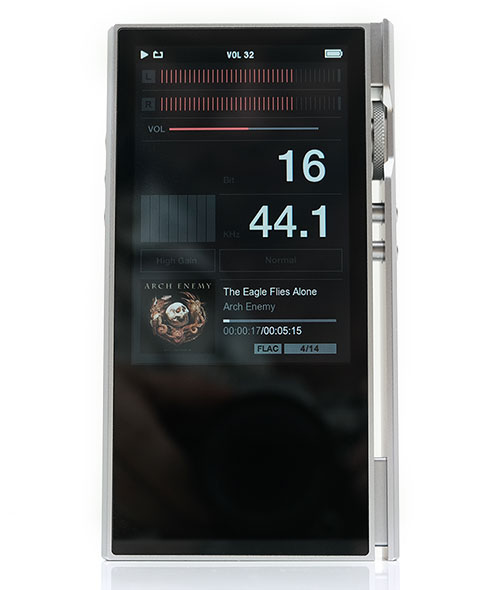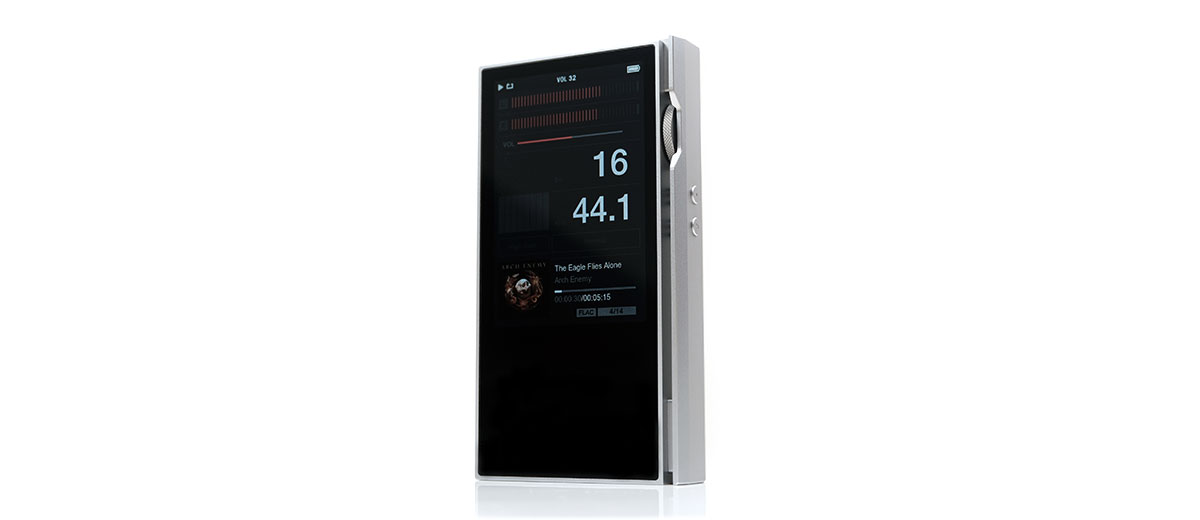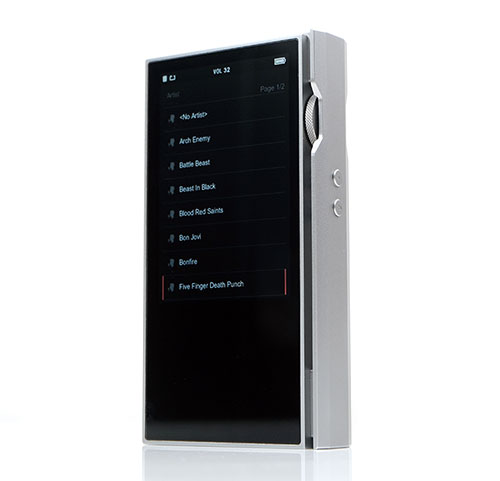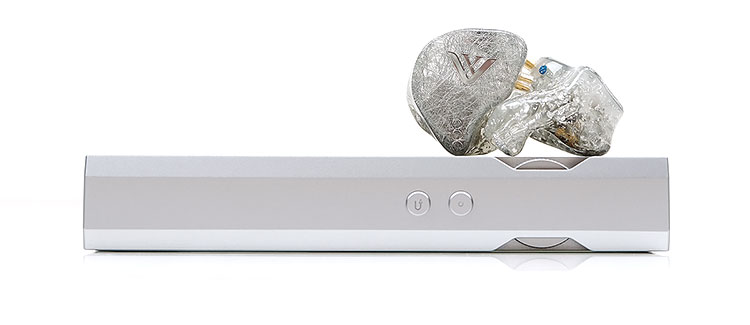Luxury & Precision P6 Software
Software
(Reviewed firmware version 1.0.0.6)
The P6 OS I presume is some sort of Linux framework with a proprietary coding layer on top for UI. In layman’s terms, it is quite a simple UI with linear information flow, lightly colored, and with the ability to display artwork on the main playback screen. Since there is no touch capability the simple way is perhaps the wisest way to go to avoid button mashing frustration.
Actually, if you are coming from the likes of the LP3 Pro then it’s a similar experience except without the touch capability which means some icon layers in corners are gone and instead you have a list-based ‘information card’ flow with text prompts that are accessible via the navigation wheel and command buttons.
The plus side is speed and stability which are both very good. The bootup time into the home menu screen is around 5 seconds from a long press and about 2 seconds to power off. I suspect the stability is from the code being relatively mature since LP has been using a version of this for years.
The speed is from its generally light and breezy resource demands on the CPU. As for the CPU itself, I have no data but my guess is an Ingenic x1000 or something similar which tends to work very well for smaller OS like this.
Navigation
Non-touch navigation is almost always linear or single direction, either drilling down or returning to the main menu. The P6 is no different in that regard with its hybrid scroll and command button navigation system.
What you are looking for here is adherence to old design principles of no more than 3 clicks to get where you want to go and a fast way to get back out. You are also hoping to avoid cul de sacs which the P6 UI does rather well.
For example, so quickly go to playback and resume play is one click, to adjust USB functionality when connected is 3 clicks, and to change the EQ preset is 2 clicks. All are within the norms or standards I would expect for good UI design for non-touch.
At any point in the system, you can get back to the main screen with a long press of the return command function button which makes media navigation a lot easier if your folder structure is deep.
Probably the only worrying aspect is any card that has a very long list in the media library causing you to endlessly scroll on that shortish IPS screen. For example, the song media manager section with 50-10k songs would be a few minutes of solid scrolling. How much strain that will put on the potentiometers volume control and electrical relay performance over the long term I am not sure.

Playback
I have to admit I like the playback screen layout. It’s a fresh approach with a mix of small and large data blocks that look like an unfinished Tetris game underneath some lavish peak meter animations. Shying away from miniaturized text data makes reading the P6 playback screen without eye strain a joy.
The code/bit rate data is huge as well as eye-catching when songs are not in play. It is most likely the first thing you will see when glancing at the screen. Once the music kicks in the top right and left peak meters animate, flowing up and down depending on the track as you would expect.
Your overall volume indicator is just below in a thin red line but you can also see it in a numerical format in the top navigation bar alongside your battery life and play status icons.
There are some washed-out gray data blocks below and beside it the track sample rate display. A gray EQ indicator that changes depending on the present and tells you also which frequency bands are emphasized is to the left.
Track metadata is also below in grey including song title, file format, and time played. The length of time of the track plus the artist’s name is in white so the block has some aesthetical contrast.
Drawbacks
Most of the drawbacks are really related to the lack of immediacy that comes with a touchscreen and the ability to change something on the fly. The UI tends to demand you think 1-2 steps ahead like a pool player rather than the reactive safety net vibe of Android’s myriad of in-play options.
For example, by holding the command button during playback or in the media library you can add tracks to playlists but you have to have created the empty playlist first to complete that action. Another example is playback order such as shuffle or loop also needs to be preset from a play mode option in the main settings menu and cannot be accessed directly from playback.

Features
Despite the graphical simplicity and linear navigation, the P6 does have some very useful features within the OS. You will find all of them within the system settings including EQ options, audio output presets which control analog and digital settings as well as environmental and BT options.
Audio Output
This is probably your most operationally relevant set of options on the P6 and mostly covered the output mode of the analog jacks as well as your digital filtering and gain controls.
You get two gain controls with the P6, high and low which also act as the voltage switch for the lineout options from the same jacks. You can switch between the two output modes from the same output settings menu.
At the very bottom of the audio output settings menu is the final switch option to change to SPDIF output. Logically I would have liked to have seen that merged with the LO/PO option menu. Logically, it seems to be a better fit inside a single output selector menu. It also removes one more yes no menu item from the main menu list to scroll down to.
You can also pick between 5 different filter options, select native or DSD to PCM decoding as well as choose DoP over your SPDIF output.

Equalizer
The EQ seems to be an 8-band option with up to 6 presets, one of which is ‘EQ off” or flat. When I say seems to be that because you do not have any ability to customize the EQ to your own preferences or offer custom presets. The presets are all you have brother.
You can see which preset is activated in the playback screen with the GUI showing the adjusted frequency gain over an 8 band stretch hence the assumption there are 8 points in the FR being considered.
As to how well the EQ performs that is down to personal preference and for me, I would choose 3 out of the 6 with off being the number 1 as it sounds more natural and with less gain attenuation.
If you feel the stock sound is too smooth then jazz is a nice alternative. It thins it out a bit but produces a nice clean sound. Rock is fun, thins out, and dips the mids in favor of that classic V-shaped bass and treble contrast. It can sound powerful and exciting but at the cost of some mids presence.
Environmental Controls
Aside from your usual display, language, and sleep options for battery management, the P6 OS also allows you to manage your USB setup inside the advanced settings menu.
You actually have 3 different USB options for the P6. There first is a connection mode, similar to Android though again you have to pre-plan in advance of connecting as it’s not an intelligent automatic thing. You have two choices, MSC for file transfer or USB-DAC input.
USB-Audio latency can also be controlled via a long or short option with the final option a choice between allowing the power supply to be from the USB connection or the battery inside the P6 when connected.

Media Management
You can dig in and manage your media via two routes, the directory option which is the basic folder and file navigation, and through the meta library options.
Directory
The folder and file drill works just like any other DAP that offers the same options and the drill-down and selecting is fast. Just be aware there is a 12000 file limit so it is possible not all of your card contents will show up if you have more.
You also have a secondary menu option by long-pressing the command button to allow you to add the files to playlists or delete the files altogether.
Meta Library
The meta library has almost the exact functionality as the drill-down file explorer with except it organizes everything more succinctly under the usual categories of artist, album, and all music, (songs). Unfortunately, the drill-down is a bit too flat for me with artist selection going straight into all the songs rather than grouping them by albums then songs.
It is also missing a genre option but personally, I have never been satisfied with most DAP OS genre management. Only a few offer proper genre-artist-album-song drill down so not having it is fine by me. The artist one would be more important in my everyday use and it does need that second album layer to drill down into properly.
Long pressing on an individual track will give you the option to add that track to a playlist that you can then access in its own area in the media library. However, you cannot delete the actual track in the meta library like you can in the file browser.
Playlists
Playlists have their own section where you can add and delete but sadly you cannot rename the playlists so if you manage a ton of them you will have to memorize what’s in them via a 1,2,3 etc… naming sequence. Not ideal.

Wireless Options
Bluetooth on the P6 is in receiver mode only and cannot transmit so there is no bi-directional capability quite as you will find in Android DAPs. That means a very simple UI navigation to the Bluetooth menu in the system settings to either turn it on or off.
You also have an option to clear ‘the pairing record’ which might mean there is an internal pairing limit for receiving. All pairing is done at your source transmitter side such as a smartphone or another DAP.
Once paired it will automatically show a BT logo on a black background with the codec being received and the sample rate in the bottom right corner. It also shows what the receiving source is, in this case, a Samsung Note 9. Nothing more required really for receiving, very neat and tidy.
Bluetooth Performance
Pairing
No operational issues here. Turn on the P6 Bluetooth, turn on your source transmitting BT device, and scan and it should see a single P6 label.
Pairing is immediate after once confirmed and you do have the option on the likes of Samsung to select LDAC quality or go for a balanced transmission and the P6 will receive both. The actual codec will be shown on the P6 screen when active including the source device, sample, and bit rates.
My one request would be able to see what devices the P6 has paired with historically. You do get the chance to clear the pairing records but what it has stored is a complete mystery.
Stability & Range
The P6 range is actually very good and competitive against most Android DAPs. Using LDAC I can get about 9m away from a smartphone transmitting before signal quality gets a bit patchy and starts dropping out.
Downgrading to SBC I can go the full 10m-11m that I usually get with an average TWS setup though to be honest the level of resolution and dynamic range from a non LDAC signal is not up to par for my tastes.
Latency
The latency on the P6 BT connection is really tight. With it connected wirelessly to a Windows 10 Acer laptop using high bitrate media files, I could not detect any looseness in the audio sync.
YouTube and Netflix were also excellent performers for audio sync, unlike TWS which can show a little frustrating lag in lip-syncing on platforms where audio sync tools are not available.
P6 Sound Impressions
(Tested using an Empire Ears Odin, Noble Audio Sultan, qdc Anole VX, and Campfire Audio’s Ara).
Summary
The P6 stock sound is special. It makes going non-touch for controls worthwhile. I thought I had heard something magical with the R2R2000 and whilst is still rate its performance as world-class, the P6 is a different and altogether more embracing sound.
This is a very natural almost analog tone but also an incredibly detailed sound signature. It has excellent solidity and density on the low-end, a broad instrumental and vocal note through the mids, and a light fade on the treble without any loss of headroom. And the dynamic range, oh my, just wonderful considering it does not have to rely on high contrast bass and treble parlor tricks.
In every IEM we tested, the P6 sounded sure-footed, powerful but with excellent resolution. However, compared to all our delta-sigma implemented DAPs the detail was not so much personified by the complexity in the arrangements, super-wide spacing, or ethereal treble complexity.
Nope, it was not on the outside of the note, but rather on the ‘inside’, metaphorically speaking. The P6 shines brightest with how it resolves and delivers the texture within each individual note. Be it voicing, string plucks, percussion brushes, or kick-drums down low, every note was broad, rich, and heavily textured to create some wonderful character therein.
Timbre
That’s the key to R2R implementations for me, they tend to make a delta-sigma alternative sound a little glossy and almost too perfect in how they project detail within each individual sound. The P6 is grittier, more involving, and throws all sorts of nuanced variations into the mix.
For example, single-string violin plucks have such broad strokes in their timbre that you can easily pick out the intentional roughness in lower G string strikes or the more mellow vibration on higher-scale A-string tones.
Those looking for a more metallic high-frequency brightness from E-string notes will find the P6 does tone it down a touch with far less chance of any nasty partial overtones. This is not a timbre that goes heavy on any upper-harmonic presence so your ear will be drawn more to the mids and low-end for harmonic coloration.
Of course, the degree of variation on the above will depend on the gear you have paired the P6 too but even finely balanced signatures such as the strong upper-mids presence of the Empire Ears Odin never felt off-course or overcooked when paired with the P6.
If there is one take away from the timbral qualities of the P6 signature and that is dynamic drivers performance within monitors, be it sole or hybrid. They tended to do better with the P6 than pure BA designs for bass texture.
The more texture you can deliver the better the P6 sounds and dynamic drivers trend to offer more than BA which, for me, is about articulation and technical excellence.
Staging
The P6 has some excellent depth and staging width with a “big vocal’ sound. The crossfeed and overall imaging remind me more of a natural stage environment rather than a big and airy arena type soundstage. This has less of an emphasis on pushing out really far and wide like some closet HD800 homage and more into a live concert feel.
A lot of that has to do with the mids presentation. Combined with that broad and heavily textured midrange instrumental and a forward vocal positioning it sounds close without the connection that can often come with that description.
That bodes well for vocal lovers who are sensitive to shouty abrasive colorations when they are pushed forward. Here they sound euphonic, ‘big’ but smooth but also contribute to a more centered and depth focused imaging quality.
Treble airiness and headroom are very good but it is not as forward or as sparkling as something like the R2R2000 Black or Lotoo’s PAW Gold Touch. It does have a gentle fade which in turn contributes to that more liquid and smoother sound from the mids downwards.
Bluetooth Sound Impressions
I think it’s really important to use the P6 in LDAC mode to get the most out of the wireless connection. For a player that places all its trump cards into smooth sound quality, using an SBC or even aptX level transmission will lead to an unacceptable loss in dynamic range leaving the presentation annoyingly compressed and flat sounding.
Even aptX robs the P6 of some much-needed headroom and throw in some unwanted bloom into that well-controlled low-end. LDAC is much better and you will hear that treble presence return right away fleshing out the soundstage a lot better and improving the perceived level of resolution immensely.
In terms of tonal change going LDAC, the general smooth tone remains but there are some nuanced differences. For example, the treble seems a little sharper, and the mid-range timbre a little lighter in vocals. Sibilance has a slighter harder edge for female vocals and percussion work marginally splashier.
The dynamic range does take a hit, but that should be unsurprising given just how excellent the wired performance is. The killer low-end that sounds softer and less impactful and little imaging clues such as a peripheral finger click not grabbing my attention as much.




